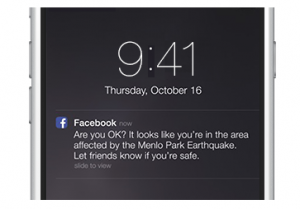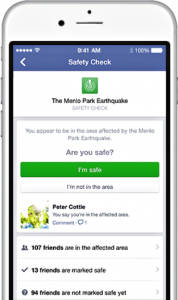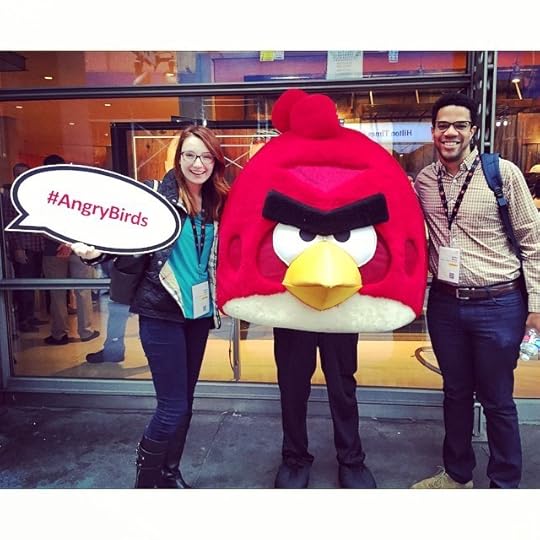Brian E. Boyd Sr.'s Blog, page 7
November 12, 2014
Top 10 Christian Twitter Accounts You Need To Follow
What is it that you want? The Word? A sermon? Inspiration? Make sure you’re following these top Christian accounts on Twitter:
1. @JoelOsteen
Stats:
3.01M Followers
11.7K Tweets
Joined Feb. 2009

2. @JoyceMeyer
Stats:
3.1M Followers
7,705 Tweets
Joined Aug. 2008

3. @BillyGraham
Stats:
147K Followers
1,657 Tweets
Joined Oct. 2008

4. @StormieOmartian
Stats:
18.8K Followers
5,317 Tweets
Joined Dec. 2010

5. @Creflo_Dollar
Stats:
406K Followers
8,177 Tweets
Joined May 2009

6. @HillsongUnited
Stats:
887K Followers
2,518 Tweets
Joined Aug. 2008

7. @Scripture_Truth
Stats:
538K Followers
28.4K Tweets
Joined Sept. 2010

8. @TBN
Stats:
41.3K Followers
5,427 Tweets
Joined Sept. 2010

9. @BethanyHamilton
Stats:
212K Followers
6,836 Tweets
Joined Jan. 2010

10. @RickWarren
Stats:
1.5M Followers
3,461 Tweets
Joined April 2007

This post was written by Sarah Boyd. Sarah is a Social Media Community Specialist with Media Connect Partners.
November 9, 2014
Why “Too Many Cooks” went viral, and what it means for your content
By now you may have heard about the viral video “Too Many Cooks” (link to CNN article. NOTE: video has mature content, if you decide to click through please keep this in mind). The video aired in the overnight hours this past week on Adult Swim, Cartoon Network’s off-peak time period.
The video is a throwback to the 1980’s when shows like “Growing Pains”, “Alf”, and “Family Matters” aired in prime-time. Why did the video go viral, and what can you do to make your own content do the same?
Some reasons we believe the video is popular:
The length was probably just right – At 11 minutes, the content was not so long that the viewer would click out, yet long enough to tell a ‘story’.
Grassroots growth – A post on Reddit first brought the video to life – then Reddit users took it from there. Reddit is a great platform to spend time in.
Over analyzation leads to discussion and sharing – On multiple platforms and in the YouTube comments for the video, consumers from around the world are analyzing the meaning of the video, “What does it all mean?”, “What was the director thinking?”, “Is it a message for the TV/Film industry?” This creates discussion which shares out of YouTube and on to other platforms.
The music brings the viewer back to their childhood (good/bad/otherwise)
We’re asked quite often how to make content go ‘viral’. There’s no magic answer. At MCP we subscribe to the following methodologies:
Wear a “white hat” – keep things above board. Don’t purchase likes, views, shares, or other growth metrics. Don’t pay bloggers to promote your brand. Find bloggers who believe in your brand and want to share your content because it’s great content.
Be diverse – There’s more to social media than Facebook. Use other platforms in your program including Reddit, Wikipedia, Vine, Keek, Snapchat, etc.
Influencers matter – Take the time to research influencers in each social platform. If that Vine star loves to share content in your business vertical, reach out and make friends

Be patient. We’ve seen content go viral weeks or months after publishing.
Like it or hate it, there’s a case study in “Too Many Cooks”.
November 6, 2014
A Graphic is Worth a 1,000 Words
A majority of social media work is written. In fact, that is what I spend most of my day doing, writing captivating snippets of information that will grab people’s attention. I have noticed however, that even the best written post will almost never preform as well as a picture or image. I recently sat down with the MCP designers and asked them to make a case for why images are the way to go on social.
Me: Why are images important in social media?
Graphics team: Simple answer? They are more interesting than written words. People are naturally more attracted to color and design. If body copy is a single note a picture can be a symphonic movement.
Me: What must good images have to stand out on Facebook and Twitter?
Graphics Team: First and foremost they have to look good. For people to engage with the work in needs to be engaging. This might sound like common sense but if an image doesn’t follow basic design theories it might not be taken seriously.
Me: I am a writer not a designer; explain to me what a good image needs?
Graphics Team: We constantly evaluate our work to make sure it is informative, clean, balanced, readable, and complements the client’s intent.
Me: Ok, I am beginning to get a better…picture…what else should I keep in mind when designing images for social?
Graphics Team: We like to use color and contrast in our images. In fact, any color can work as long as it can provide contrast. There is no specific color recommended for use on social media, each color has its own meaning and purpose. Therefore, it all depends on what you want your audience to see and feel when they see any particular image. Contrasting and complimentary colors are highly recommended, as they simple look better together. Color contrast can really bring an image together.
Me: Where do you draw your creative stimulation from?
Graphics Team: We keep up with trending works and new styles. For example, blues, and greys are very in right now, oranges and yellows are not. Nature is also a huge inspiration; a day at the beach or in a park can almost always wash away any creativity block.
Me: Got an example you want to share real quick?
Graphics Team: Yeah, look at the colors used in these images and see how they are all complementary of each other yet provide contrast and complete the image.


Me: This was great, thank you both! I have a new found respect for your work, but I think I will stick to what I know best.
This post was written by Chandler Elmore. Chandler is a Social Media Content Specialist with Media Connect Partners.
Keeping Your Focus on God During the Holidays
Yes. We all know those people. “It’s November, and they are already selling Christmas decorations?!” Well, November has arrived and we all know what that means! Unofficially, the Christmas season is underway. Thanksgiving, move over. Bring on the Christmas décor. But with the holiday season comes the risk of getting wrapped up in the business of wrapping paper, shopping, gifts, and delicious meals—and missing the real Reason for the Season.
Here are five quick ways to not only survive the holidays—but to keep your focus on Jesus in the midst of it:
Keep daily reminders. Whether it’s something simple like downloading a “Daily Bible Verse” app or setting a calendar reminder to pause and reflect once a day—do something that brings you back to the purpose of this season and of every day on this earth.
Pray. We’re only human. And whether we care to admit it or not, we will lose sight at one point or another during the holidays—whether it’s fighting over that last My Little Pony doll that your niece was vying for or grumbling at the less than cheerful salesperson—it’s nothing prayer can’t help. Ask God every day to help you stay focused.
Give. I think there are few things that can make you grasp the real message of Jesus like giving to others. Whether it’s dedicating a whole day to filling as many shoeboxes for “Operation Shoebox” as you can, or bringing Christmas meals to a family in need—care for those who God has called you to help.
Breathe. Take time to just be in God’s Word. Sometimes in the craziness of family and friends visiting, running errands, and decorating, you just run out of steam. Refuel with God’s Word in those moments! Let Him bring the peace and strength you need.
Be thankful. If you ever need a reason to remember why we celebrate the birth of Jesus—just think of the blessings on your life! Whenever you start feeling like the Grinch is taking over, stop and meditate on one thing you’re thankful for. Give praise for that! And if you feel like you don’t have anything to be thankful for in that moment—just remember that you have eternal life; so that right there is the greatest gift you could ever receive!
This post was written by Jackie Silva. Jackie is a Lead Social Media Content Specialist with Media Connect Partners.
October 29, 2014
Old School Media: A Simpler, Better Time?
Merriam Webster defines the word medium as “a particular form or system of communication (such as newspapers, radio or television).” Notice how they still list the old school media in the parentheses? Radio, newspapers and television: the beginning of mass media. These ways of communication are still relevant today, but thanks to social media and new technology it’s now at our fingertips. However, that doesn’t seem to matter. According to some statistics, we still prefer the old school methods.
Although lots of newspaper companies had a big fallout in readership and were forced to let go of thousands of staff a few years back, Scarborough Research noticed an increase in readership last year in print and online. “The vast majority of U.S. adults, 164 million (69%), read newspaper media content in print or online in a typical week, or access it on mobile devices in a typical month,” (naa.org). So while printed newspapers may not be the main medium of readers, there is still an audience for newspaper companies online. Whether you’re reading in front of your breakfast on that black and white paper or on your tablet screen, you are still reading from an “old school” medium.
Radio advertisements still reach 243,768,000 every week (RAB.com)! Honestly, some social platforms still don’t have those numbers. I still listen to the radio in my car to and from work. Now, I change the station if there is a commercial playing, but that doesn’t mean I’m not in ear shot of that radio ad. Same thing with Facebook impressions; you may keep scrolling, but that ad was in your news feed and is still accessible. The ad is still doing its job.
After radio came the magic of the Television. My grandpa still had a little Technicolor screen with a turn dial switch up until he moved in with my aunt and he was introduced to more than 13 channels. Even then, he still watched the news and Matlock every day. Bet you wouldn’t believe that watching videos on TV is still the most common medium today (Nielsen.com). We have smart phones, tablets, and computers and consumers still watch more than an average of 146 hours of TV each month (Nielsen.com).
The point is, we started out with 3 stations on the radio, 13 channels on our TVs, and today we have unlimited channels, stations and all kinds of technology at our fingertips. But we still prefer the old school methods of media. Maybe, we prefer that simpler time we grew up with? Maybe social media is still too new and one day will replace the old media?
What do you think? What’s your preferred medium to use? Why do you think statistics for old school media are so high? Tell us in a comment below!
This post was written by Ginger Marks. Ginger is a Social Media Community Specialist with Media Connect Partners.
Statistics from: Nielsen.com, RAB.com , and NAA.org
5 Social Media Mistakes in Ministry
Social media has allowed millions of churches and ministries the opportunity to connect with people on a more personal level and use the platforms to amplify the Word of God. For a church or ministry, that means the opportunity to spread the good news to millions of people who have yet to know or have a relationship with Jesus.
But, just because you’re on social media doesn’t mean you fully understand how best to utilize it. Here are five common mistakes churches or ministries make:
All Business, No Social: Keep the “social” in social media by not posting exclusively about you or your ministry, such as small group meetings or the next sermon topic. Follow MCP Faith’s 70/30 rule: 70% sharing/social interactions and 20% promotional/announcements. This healthy mix of promotional and non-promotional content helps your ministry be gracious by quoting and promoting others while avoiding the selfishness of the “me-first” mentality.
Not Posting Enough: Do you update your social media pages only when the Spirit moves you? Try to update your social media pages daily, or at least every few days, so your audience knows the page is active and a resource for information. If time is working against you, utilize the platforms’ internal scheduling option or a social media management program such as Hootsuite, Sprout Social, or Buffer to schedule posts in advance.
Posting Too Often: Just as not posting enough online is a social media misstep, posting too frequently is another faux pas. If you’re signing into your social media account and posting back-to-back then you’re high-jacking readers’ newsfeed. In order to not overwhelm users who connected with you online, sprinkle your posts, don’t dump them all at once. Utilize a social media management tool, such as the options listed above, to help distribute posts on different days and at different times.
Words, Words, and Lack of Visuals: I’m guilty of it and you probably are too – you’re scrolling through your newsfeed and skimming right over text-only posts. It’s true. Viewers are more likely to be interested in a post if there’s a visual element attached to it such as a photo, video, or link with an image preview. Be sure to mix up the medium in your posts so your posts don’t get grazed over.
Ignoring Those You’re Connected With: When your ministry is setup on social media, it’s likely people will reach out with questions, feedback, complaints, and prayer requests. Make sure a dedicated individual or team is checking public messages as well as private messages and engaging with the audience online. Your online presence should be an extension of the face-to-face ministry you offer at church.
Are you making any of these mistakes?
If you are making some of these mistakes with your church’s social media pages, don’t worry. You can easily fix them with a little thought and time or with the help of MCP: Faith’s expert social media team. Contact us today at 1.800.627.1265 or info@mcpfaith.com
This post was written by Ashley Scolaro. Ashley is an Account Director with Media Connect Partners.
October 22, 2014
Blogging for the Christian Business
Blogging is a relatively inexpensive and fun way to promote your business/organization while engaging with your social audience in a more personal way. We think blogging is so great that we write blogs about blogging, so get your pen and paper and pick up some blogging tips for your Christian business. Let’s face it, not many people have the time to reach out to each individual who supports their business/organization personally. Blogging opens up a door for you to share about your products and services, share your expertise, engage people through personal experiences, and even answer customer questions in an easy and friendly manner. Blog software is generally easy to use and there are many blogging tools and websites to get the job done such as WordPress.com, Blogger.com, and Tumblr.com. You can even add a blog page to your own company website for easy access. 
Blogging is especially great for Christian businesses because it allows you to share your heart with the community. You can post about events, charities, articles that support your cause and beliefs, and generally engage people on a deeper level than you can through a website. Don’t forget to share your blog posts through your other social media platforms such as Facebook, Twitter, and Pinterest.

Here are 7 tips to make your blogging effective and reach the right audience:
1. Keywords: Having a blog that no one can find is pointless so make sure to include all the great words that up your SEO and attract people who would be likely to engage in your brand. Make sure that your heading is short and interesting.
2. Links: Linking to other blogs of people who support your company or to articles and videos that support your blog is a great way to get more engagement and exposure.
3. Layout: Make sure your blog is well written, clean, and easy to read to ensure that people actually read your whole blog, share it, and hopefully come back for more.
4. Guest Bloggers: Getting other people/influencers to write about/for your blog is a great way to reach new audiences and show that you are part of a community if like-minded people.
5. Images: Make sure to use images to your advantage when blogging. A well placed image can break the harshness of text-heavy posts and make your blog interesting and visually appealing.
6. Video Content: Don’t underestimate the power of a video embedded into your blog, or even a video blog post (Vlog). Many people would much rather watch a quick video than read a post and this also opens up opportunity for you to share tutorials, adverts, and advice.
7. Keep It Interesting: A great way to get people to engage with your blog is to ask a question, share a shocking fact or statistic, create a quiz, or post a great quote or Scripture and ask for feedback. If your Christian business/organization isn’t already blogging, we suggest you look into a few quick and easy blog sites. Start small, post regularly, and offer the community something they haven’t seen before.
This blog was written by Kirstin Venn. Kirstin is a Social Media Content Specialist for Media Connect Partners, LLC.
Are Your Friends and Family OK? Facebook’s “Safety Check” Can Tell You
It has become common in times of disaster or crisis for people to go to Facebook and check on loved ones and receive updates. This past week Facebook announced a new tool called Safety Check that will notify your friends and family so that they know you’re ok after a major disaster.
Facebook said the “2011 earthquake and tsunami in Japan, which affected more than 12.5 million people, showed the need for such a feature….in times of disaster or crisis, people turn to Facebook to check on loved ones and get updates. It is in these moments that communication is most critical both for people in the affected areas and for their friends and families anxious for news.”
Here’s how Facebook Safety Check works:
When a natural disaster happens in your area, Facebook will send you a message asking if you’re ok. Facebook determines your city by your profile and if the city is wrong, you can easily mark that you’re not in the affected area.

https://www.facebook.com/about/safety...
If you’re ok, you can easily select a message saying “I’m safe” and a notification and News Feed story will be generated with your update. In case you cannot access the internet, friends can also mark you as safe on your behalf.

https://www.facebook.com/about/safety...
If you have friends in the area of a natural disaster and the tool has been activated, you’ll get a notification about those who have marked themselves as safe. Clicking on the notification will take you to the Safety Check bookmark that will show a list of their updates.
Only friends will see a user’s safety status and the comments he or she shares about the situation. Safety Check will be available globally on Android, iOS, feature phones and desktop computers.
This blog was written by Matt Gregory. Matt is the Vice President of Operations for Media Connect Partners, LLC.
October 15, 2014
MCP Takes on #AWXI
In the spring, New York City is filled with tourists. In the summer we fill up on food festivals. Fall in New York City is conference season – there’s no other way to describe it.
We’re fortunate to be able to participate in these knowledge transfer sessions from some of the United States’ biggest executives representing Fortune 500 companies and tech companies alike. Advertising Week 2014 was exactly that; an event where Johnson & Johnson met Tumblr, Yellow Pages met Yahoo!, and Buzzfeed met Purina.
As a social media agency, it’s important to stay on top of the latest marketing trends.

Here are a few takeaways from Advertising Week 2014:
Layer your content: Buzzfeed’s EVP of Video, Ze Frank, explained the importance of “the list”, and how their approach of layering content retains audience viewership. Have you thought of this approach for your companies blogging?
Don’t forget your neighbors: CMO of Yellow Pages, Allison Checchi, reminded us that “local” is a passion point for people. Don’t try to blanket your local markets with the same message you’re giving your global audience.
Engagement is the new currency: Katie Redlien, Senior Brand Manager for BACARDÍ Rum USA told us that we live and die by our fan base. Do everything you can to appeal to the people who love you already. When opportunities come up for major reach, jump all over it!
This blog was written by Jordan Moran. Jordan is an Account Manager at Media Connect Partners.
Why Every Christian Publishing Company Should Be Using Social Media
Are you a Christian publishing company that’s debating on whether or not to invest time, money, and resources into social media for recently published books? Well your answer should simply be, yes! Below are a few reasons why every Christian publishing company should be using social media:
Generate Awareness: Social media can play a key factor in generating awareness for newly published books. One way to generate awareness is to create shareable content. For example, a strong quote with a shareable image is a great way to build shareable content. When an image is ‘shared,’ more awareness is being generated, because a wider audience is able to see your content. Therefore, this is helping to spread awareness for your book to a wider audience.
Build Community: Not only will you generate awareness for books by using social media, but social media is also a great opportunity to build a community of supports around the book or brand. After people are aware of your new book, or are becoming aware of it, they also want to feel as if they can relate to the book in a meaningful way. One way to build community is to take a particular theme of the book that people can relate to, and craft posts around it on a certain day. For example, for our client, Harvest House Publishers, we created many themes to build community around Stormie Omartian’s books on her social media platforms. One being, #MarriageMonday, this has been a successful way to build community around the topic of marriage that’s addressed in many of her books. The hashtag, #MarriageMonday, is a great way to build community with Stromie Omartian’s online audience, because her audience can relate to the struggles and look to seek support around the topic.
Drive Book Sales: Let’s be honest, one of the ultimate reasons for why publishing companies use social media today is to drive book sales. Social media is a great way to drive sales, because you can include trackable links to your content that drives people back to your website to purchase the book. One way to do this is to provide soft marketing to your audience. For example, sharing a strong quote from the book with a retail link to the book at the end of the quote.
There are many reasons for why Christian publishing companies consider and use social media for their published books. Some other reasons could be to build excitement, generate engagement and interactions, or to simply provide a page where people can learn more. Whatever your goals may be, social media is a great way to achieve them.
This post was written by Bethany Couture. Bethany is a Social Media Content Specialist with Media Connect Partners.
Brian E. Boyd Sr.'s Blog
- Brian E. Boyd Sr.'s profile
- 5 followers



